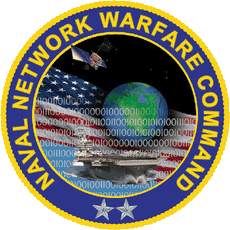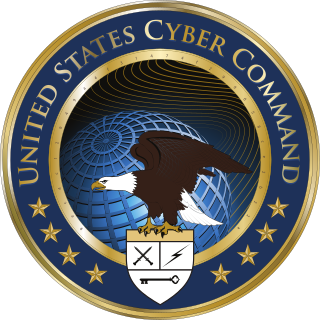The United States Armed Forces are the military forces of the United States. The armed forces consists of six service branches: the Army, Marine Corps, Navy, Air Force, Space Force, and Coast Guard. All six armed services are among the eight uniformed services of the United States.

Communications security is the discipline of preventing unauthorized interceptors from accessing telecommunications in an intelligible form, while still delivering content to the intended recipients.

The National Communications System (NCS) was an office within the United States Department of Homeland Security charged with enabling national security and emergency preparedness communications using the national telecommunications system. The NCS was disbanded by Executive Order 13618 on July 6, 2012.

An intrusion detection system is a device or software application that monitors a network or systems for malicious activity or policy violations. Any intrusion activity or violation is typically reported either to an administrator or collected centrally using a security information and event management (SIEM) system. A SIEM system combines outputs from multiple sources and uses alarm filtering techniques to distinguish malicious activity from false alarms.
The Navy/Marine Corps Intranet (NMCI) is a United States Department of the Navy program which was designed to provide the vast majority of information technology services for the entire Department, including the United States Navy and Marine Corps.
The United States Computer Emergency Readiness Team (US-CERT) is an organization within the Department of Homeland Security’s (DHS) Cybersecurity and Infrastructure Security Agency (CISA). Specifically, US-CERT is a branch of the Office of Cybersecurity and Communications' (CS&C) National Cybersecurity and Communications Integration Center (NCCIC).
Network-centric warfare, also called network-centric operations or net-centric warfare, is a military doctrine or theory of war that aims to translate an information advantage, enabled partly by information technology, into a competitive advantage through the computer networking of dispersed forces. It was pioneered by the United States Department of Defense in the 1990s.

Cryptologic Technician (CT) is a United States Navy enlisted rating or job specialty. The CT community performs a wide range of tasks in support of the national intelligence-gathering effort, with an emphasis on cryptology and signal intelligence related products.

Mass Communication Specialist is a United States Navy public affairs type rating. MCs practice human-centered design to develop creative communication solutions and align communication strategies and tactics to leadership's intent; conduct research and develop audience profiles; prepare, process, and print publications and media products; create sketches, storyboards, and graphics; design publications; produce still imagery, and written, audio, video, and multimedia information products; collect, analyze, and report media project and communication plan feedback and performance information; create media project plans; conduct community outreach, news media operations, leadership communication operations, and organizational communication operations; plan and direct communication campaigns and events and serve as communication advisors to commanders; and develop content strategies, create data stories, and ensure communication products and experiences are designed to enhance understanding and discoverability. MCs serve aboard ships, in expeditionary units and at shore commands in the United States and overseas.

The United States Africa Command, is one of the eleven unified combatant commands of the United States Department of Defense, headquartered at Kelley Barracks, Stuttgart, Germany. It is responsible for U.S. military operations, including fighting regional conflicts and maintaining military relations with 53 African nations. Its area of responsibility covers all of Africa except Egypt, which is within the area of responsibility of the United States Central Command. U.S. AFRICOM headquarters operating budget was $276 million in fiscal year 2012.

Naval Network Warfare Command (NETWARCOM) is the United States Navy's information operations, intelligence, networks, and space unit. Naval Network Warfare Command's mission is to execute, under Commander TENTH Fleet Operational Control, tactical-level command and control of Navy Networks and to leverage Joint Space Capabilities for Navy and Joint Operations.

The Air Defense Identification Zone of North America is an air defense identification zone (ADIZ) that covers the airspace surrounding the United States and Canada – in which the ready identification, location, and control of civil aircraft over land or water is required in the interest of national security. This ADIZ is jointly administered by the civilian air traffic control authorities and the militaries of both nations, under the auspices of the North American Aerospace Defense Command (NORAD). The Federal Aviation Administration (FAA) handles the requests of international aircraft and Transport Canada handles Canadian requests. Any aircraft flying in these zones without authorization may be identified as a threat and treated as an enemy aircraft, potentially leading to interception by fighter aircraft.

The United States Marine Corps (USMC), also referred to as the United States Marines, is the maritime land force service branch of the United States Armed Forces responsible for conducting expeditionary and amphibious operations through combined arms, implementing its own infantry, artillery, aerial, and special operations forces. The U.S. Marine Corps is one of the eight uniformed services of the United States.

United States Cyber Command (USCYBERCOM) is one of the eleven unified combatant commands of the United States Department of Defense (DoD). It unifies the direction of cyberspace operations, strengthens DoD cyberspace capabilities, and integrates and bolsters DoD's cyber expertise.
Cyberwarfare is the use of computer technology to disrupt the activities of a state or organization, especially the deliberate attacking of information systems for strategic or military purposes. As a major developed economy, the United States is highly dependent on the Internet and therefore greatly exposed to cyber attacks. At the same time, the United States has substantial capabilities in both defense and power projection thanks to comparatively advanced technology and a large military budget. Cyber warfare presents a growing threat to physical systems and infrastructures that are linked to the internet. Malicious hacking from domestic or foreign enemies remains a constant threat to the United States. In response to these growing threats, the United States has developed significant cyber capabilities.

The U.S. Marine Corps Forces Cyberspace Command is a functional formation of the United States Marine Corps to protect critical infrastructure from cyberattack. Marine Corps Forces Cyberspace Command is the Marine Corps component to U.S. Cyber Command. It comprises a command element, the Marine Corps Cyber Operations Group, and the Marine Corps Cyber Warfare Group, a total of approximately 800 personnel. MARFORCYBER was established on January 21, 2010 under the command of LtGen George J. Flynn,. As of 7 July 2021, MajGen Ryan P. Heritage is in command.

An information security operations center is a facility where enterprise information systems are monitored, assessed, and defended.
Information Operations is a category of direct and indirect support operations for the United States Military. By definition in Joint Publication 3-13, "IO are described as the integrated employment of electronic warfare (EW), computer network operations (CNO), psychological operations (PSYOP), military deception (MILDEC), and operations security (OPSEC), in concert with specified supporting and related capabilities, to influence, disrupt, corrupt or usurp adversarial human and automated decision making while protecting our own." Information Operations (IO) are actions taken to affect adversary information and information systems while defending one's own information and information systems. In the United States Navy, information operations are often supervised by a Navy Information Operations Command (NIOC), for example in the United States Tenth Fleet which has several NIOCs.

India–Mauritius are the historical, political, economic, military, social and cultural connections between the Republic of India and the Republic of Mauritius. Connections between India and Mauritius date back to 1730, diplomatic relations were established in 1948, before Mauritius became independent state. The cultural affinities and long historical ties between the two nations have contributed to strong and cordial relations between the two nations. More than 68% of the Mauritian population are of Indian origin, most commonly known as Indo-Mauritians. India and Mauritius co-operate in combating piracy, which has emerged as a major threat in the Indian Ocean region and Mauritius supports India's stance against terrorism.












